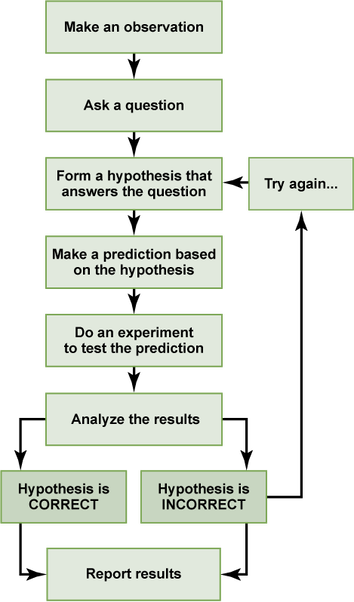Physics
Click on the subject you want to study
The Scientific Method
|
The scientific method is a process that is used to find answers to questions about the world around us. There are several versions of the scientific method. Some have more steps, while others have only a few. All versions of the scientific method include a question to be answered, a hypothesis, and an organized method for conducting and analyzing an experiment.
Watch the video for more information about the scientific method and look at the flow-chart to see the steps of the scientific method laid out. Download the worksheet below to practice using the scientific method:
| |||
Forces & the Laws of Motion IThe three laws of motion were first written down by Isaac Newton in the 17th century, and they describe the rules of motion of material objects.
|
Watch this video for a more in depth description of the three laws of motion, or read more about them here. Then download this worksheet to practice applying the laws of motion to real-life examples.
| ||||||
- Newton's first law is also called the law of inertia, which basically means that an object will either stand still or keep moving until another force acts upon it, such as friction, or the force that resists the sliding or rolling of one solid object over another.
- Newton's second law gives us the equation F = ma, or force = mass x acceleration. Force is a physical influence, which when applied to an object causes it to accelerate in the direction from which it was applied. Mass is the amount of matter in an object and is expressed in kilograms. Acceleration is the rate of change of velocity of an object in the same straight line of the unbalanced force. The second law states that the rate of change of velocity of an object is directly proportional to the force applied and takes place in the direction of the force.
- Newton's third law is also known as the law of action and reaction. It states that when two bodies interact, they apply forces to one another that are equal in magnitude and opposite in direction.
Forces & the Laws of Motion IIReview important terms about force and the Laws of Motion in this online activity, and then download the worksheets to practice answering critical thinking questions, as well as F=MA equations:
|
| ||||
Speed, Velocity & Acceleration
|
Watch the video to learn more about speed, velocity & acceleration, then download the worksheets to practice answering problems using the appropriate equations:
|
Speed is the distance an object travels in a certain amount of time, you know the speed of the object. For example, if a car travels 70 miles in one hour, the car is traveling at a speed of 70 miles/hour. If the speed of an object does not change during its motion, the object is traveling at a constant speed.
Velocity is the speed of an object traveling in a particular direction. For example, the same car traveling 70 miles/hour going north is describing the velocity. An object can increase in speed or decrease in speed. The direction an object travels can also change. A car can travel north for 20 meters and then turn right and travel west for 50 meters. When an object changes speed or direction, this is called acceleration. Acceleration is the rate at which velocity changes. | ||||||
Types of Energy
|
Energy is defined as the ability to do work. Modern civilization is possible because people have learned how to change energy from one form to another and then use it to do work. People use energy to walk and bicycle, to move cars along roads and boats through water, to cook food on stoves, to make ice in freezers, to light our homes and offices, to manufacture products, and to send astronauts into space.
There are many different forms of energy, including chemical, electrical, mechanical, nuclear and thermal. Read about these different types of energy in the slides below: |
|
Potential vs. Kinetic Energy
All forms of energy can be grouped into two general types of energy for doing work: potential or kinetic.
- Potential energy is stored energy and the energy of position
- Kinetic energy is the motion of waves, electrons, atoms, molecules, substances, and objects
|
|
Read more about the different types of energy and answer some practice GED questions below:
| ||||
Transfer of Energy & Work
|
|
Energy cannot be created or destroyed, meaning that the total amount of energy in the universe has always been and will always be constant. However, this does not mean that energy is immutable; it can change form and even transfer between objects.
A common example of energy transfer that we see in everyday life is the transfer of kinetic energy—the energy associated with motion—from one moving object to a stationary object via work. In physics, work is a measure of energy transfer and refers to the force applied by an object over a distance. When a golf club is swung and hits a stationary golf ball, some of the club’s kinetic energy transfers to the ball as the club does “work” on the ball. In an energy transfer such as this one, energy moves from one object to another, but stays in the same form. Read about other types of energy transfers here. Watch the video about how to calculate work, and then download the practice equations below:
| ||
Physics Review
Take this GED practice test to review all you've learned this quarter:
| physics_review.pdf |









